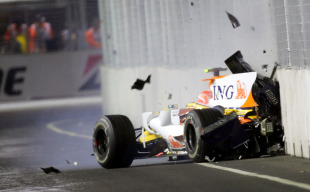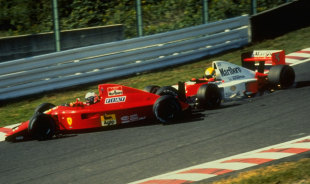- Top Ten ... controversies in Formula One
The shadowy side of Formula One

- Drivers:
- Fernando Alonso
- |
- Lewis Hamilton
- |
- Damon Hill
- |
- Max Mosley
- |
- Nelson Piquet Jnr
- |
- Alain Prost
- |
- Michael Schumacher
- |
- Ayrton Senna
Controversy is never far away in the sport of Formula One. We look back on ten incidents that have made the headlines for the wrong reasons
2009: 'Crashgate'
After a poor qualifying session that left him 15th on the grid at the 2008 Singapore Grand Prix, Renault's Fernando Alonso was the first driver to make a routine pit stop for fuel and tyres on lap twelve, rejoining the race at the back of the field. Three laps later, Alonso's team-mate, Nelson Piquet Jr., crashed into the circuit wall at turn 17 bunching the cars up behind the safety car before the pit lane re-opened. Consequently, most of the leading cars ended up behind Alonso after their stops and the Spaniard went on to win the race after Piquet's timely accident. After being dropped by Renault following the 2009 Hungarian Grand Prix, an angry Piquet revealed that he had been asked by the team to deliberately crash to improve the race situation for Alonso and the FIA promptly charged Renault with conspiracy. Renault stated that they would not contest the charges, and announced that the team's managing director, Flavio Briatore, and executive director of engineering, Pat Symonds, had left the team. Briatore was suspended from all F1 and FIA-sanctioned events indefinitely, whilst Symonds received a five-year ban. Their bans were subsequently overturned by a French court, although they both agreed not to work in Formula One or FIA-sanctioned events as part of a later settlement reached with the governing body.
2007: The Max Mosley sex scandal
In March 2007, the News of the World tabloid paper posted video evidence that FIA boss Max Mosley had engaged in sadomasochistic sexual acts with five prostitutes in a Chelsea basement flat. Mosley apologised for any embarrassment the revelations caused to his family and the sport and insisted there was no truth to the allegations that Nazi role-play was involved. He condemned the invasion of his privacy as part of a covert operation to discredit him and was awarded £60,000 damages and £450,000 in legal fees.
2005: Indianapolis and the three team race
The 2005 United States GP was one of the most controversial F1 races in history. Following several tyre failures, Michelin advised its customer teams that the tyres they provided were not safe enough to last the entire race. Given that the 2005 rules demanded that tyres last the entire race, Michelin-supplied cars had no option but to pull out. The race turned into a needless farce when just six cars from Ferrari, Minardi and Jordan started the race.
2009: 'Liegate'
McLaren were stripped of their race points in Australia after being charged with bringing the sport into disrepute by lying to race stewards. The controversy started when McLaren protested Jarno Trulli's third place for Toyota because they said the Italian had illegally overtaken Hamilton behind the safety car. Behind closed doors, however, Hamilton told the stewards that he had received no instruction to allow Trulli past, and had not consciously done so. But radio recordings later revealed that McLaren had told Hamilton to move over for Trulli, who was reinstated to the podium. The stewards decided that Hamilton and McLaren had misled them, having contradicted the available evidence. Hamilton was disqualified and McLaren stripped of their constructors' points. McLaren sporting director Dave Ryan was sacked.
2002: Team orders in Austria
The 2002 Austrian GP will always be remembered for its staged finish after race leader Rubens Barrichello was ordered by Ferrari to allow his team-mate Michael Schumacher to overtake him and win. Ferrari wanted Schumacher to take maximum points for the drivers' championship and the Brazilian grudgingly obliged allowing Schumacher to pass him on the last lap at the finish line. The FIA have since created new rules banning team orders affecting race outcomes.
2007: 'spygate'
The F1 espionage controversy was arguably the biggest scandal to hit the sport. Ferrari alleged that former employee Nigel Stepney has passed on critical technical details to McLaren engineer Mike Coughlan leading to the commencement of a criminal investigation by the Modena district attorney in Italy. The crucial FIA hearing resulted in several penalties for McLaren for illicitly collecting and holding information from Ferrari to confer a dishonest and fraudulent sporting advantage. McLaren was excluded from the constructors' standings and a record fine of US100 million.
1994 and 1997: Schumacher's unsporting behaviour
When Michael Schumacher collided with Damon Hill in the 1994 Australian Grand Prix at Adelaide, it secured him his first world drivers' championship. Schumacher has always maintained that the collision was a racing incident but Hill has always maintained that Schumacher deliberately drove into him in his crippled Benetton. And in the 1997 European Grand Prix, Schumacher again appeared to deliberately try to take out Jacques Villeneuve to secure himself the title. This time, he failed.
2009: Racism hits F1 The stigma of racism hung over F1 after a fan with a blacked-up face in imitation of world champion Lewis Hamilton was filmed at the 2009 Spanish GP. It came after a similar incident during a test session at the same circuit caused outcry in February 2008. The incident - when a group of people with their faces painted black wearing t-shirts adorned with the words 'Hamilton's family', caused outrage and prompted the FIA to launch an anti-racism initiative, EveryRace.

1990: Senna v Prost and the dirty line
Ayrton Senna's ruthless will to win at all costs was no better displayed than in the 1990 Japanese GP. Having secured pole position, the Brazilian was unhappy with the side of the track it was situated on, claiming that pole should always be on the racing line and not the dirtier side of the track. Senna's request to be moved to the favourable side was rejected, so when his rival Alain Prost passed him at the start, Senna took out Prost on the first corner to secure the world championship.
1994: The death of Senna
Although Ayrton Senna almost certainly died at the circuit when his car hit the wall at Tamburello on May 1, 1994, the FIA and Italian authorities still maintain that he died later in hospital. Under Italian law when a person dies at a sporting event, that death must be investigated immediately, causing the sporting event to be cancelled. If Senna died instantly, the race organisers may have delayed any announcement to avoid a race cancellation and a loss of an estimated at US 6.5 million. The Williams team was entangled for many years in a court case with the Italian prosecutors over manslaughter charges, but they were found not guilty and no action was taken against Williams. In 2004, the case was re-opened, but closed again in 2005 when there was no new evidence.

